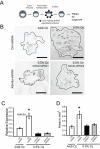Ex vivo Trophoblast-specific Genetic Manipulation Using Lentiviral Delivery
- PMID: 29367940
- PMCID: PMC5777579
- DOI: 10.21769/BioProtoc.2652
Ex vivo Trophoblast-specific Genetic Manipulation Using Lentiviral Delivery
Abstract
In this protocol report, we describe a lentiviral gene delivery technique for genetic modification of the rat trophoblast cell lineage. Lentiviral packaged gene constructs can be efficiently and specifically delivered to the trophoblast cell lineage of the blastocyst. The consequences of 'gain-of-function' and 'loss-of-function' blastocyst manipulations can be evaluated with in vitro outgrowth assays or following transfer to pseudopregnant rats.
Keywords: Blastocyst; Lentiviral vector; Placenta; Trophoblast.
Conflict of interest statement
Authors declare no conflict of interest or competing interests.
Figures


References
-
- Ain R., Canham L. N. and Soares M. J.(2003). Gestation stage-dependent intrauterine trophoblast cell invasion in the rat and mouse: novel endocrine phenotype and regulation. Dev Biol 260(1): 176-190. - PubMed
-
- Ain R., Konno T., Canham L. N. and Soares M. J.(2006). Phenotypic analysis of the rat placenta. Methods Mol Med 121: 295-313. - PubMed
-
- Chakraborty D., Cui W., Rosario G. X., Scott R. L., Dhakal P., Renaud S. J., Tachibana M., Rumi M. A., Mason C. W., Krieg A. J. and Soares M. J.(2016). HIF-KDM3A-MMP12 regulatory circuit ensures trophoblast plasticity and placental adaptations to hypoxia. Proc Natl Acad Sci U S A 113(46): E7212-E7221. - PMC - PubMed
Grants and funding
LinkOut - more resources
Full Text Sources
Other Literature Sources
Research Materials

